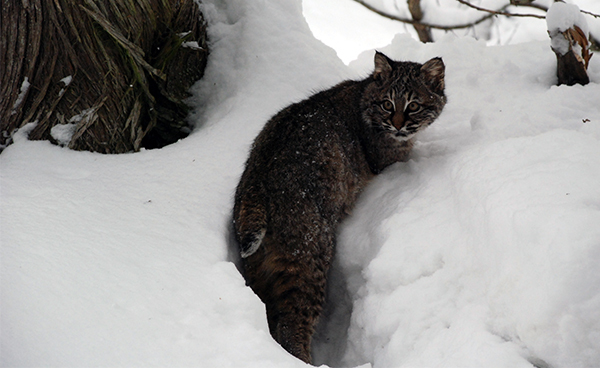 Nov. 22, 2019
Contact: Contact: Gary Willis, 906-353-6651, ext. 112 or John Pepin, 906-226-1352
Bobcats and snowshoe hares in the spotlight at DNR ‘Wildlife Through Forestry’ forum in Ishpeming
Dec. 3 presentation continues ongoing educational series
An excellent opportunity to learn more about populations and habitat of bobcats and snowshoe hares is set for Dec. 3, continuing the DNR’s successful “Wildlife Through Forestry” forums.
“This is another offering in our exciting series which explores the connections between forests and wildlife,” said DNR service forester Gary Willis. “Since 2017, all these events in this series have provided great chances to get together to have fun and to learn something new at the same time.”
The free “Snowshoe Hare and Bobcat – Populations and Habitat” forum, open to the public, will be held from 5:30 to 9 p.m. EST at the River Rock Lanes and Banquet Center, 1011 North Road, in Ishpeming.
Those arriving an hour early can meet with resource professionals to discuss management of their forest and wildlife resources.
The featured speakers will be Gary Roloff, professor of wildlife biology at the Michigan State University Department of Fisheries and Wildlife, Chris Jacques, a professor and researcher at Western Illinois University, and Eric Clark, lead biologist for the Sault Ste. Marie Tribe of Chippewa Indians.
Roloff directs the Applied Forest and Wildlife Ecology Lab at MSU. He is one of the leading authorities on snowshoe hare populations and habitat in the Lake States, while Jacques has done extensive research here on bobcat and predator-prey interactions. Clark will discuss the importance of snowshoe hare to the Soo tribe and the use of high-tech tools to conserve the species in Michigan.
Snowshoe hares are an important prey species for many Upper Michigan predators, especially bobcat, fisher and pine marten which depend on hare abundance. Because their digestive system includes a highly specialized pouch that contains bacteria that can digest cellulose, hares can thrive on poor sites by browsing woody twigs, buds and conifer needles. They are also called “varying” hares for their ability to shed brown fur for white as the seasons change. Roloff’s presentation will discuss what is known about hare population fluctuations and the roles of predation, habitat and climate.
Bobcats are a “cat of the shadows.” Pound-for-pound, they are formidable hunters even taking down deer in deep snow. Their home ranges are large and include many square miles. Research is showing that management for bobcat involves the retention of travel corridors connecting various habitat types bobcat depend on. Jacques’ presentation will offer an in-depth summary of his research on bobcat ecology and habitat needs.
The DNR launched its forums designed to demonstrate to private landowners that they can accomplish their wildlife habitat enhancement goals and objectives by careful implementation of a well-written resource management plan.
As part of this effort the DNR has been offering its popular “Wildlife Through Forestry” forums in the western Upper Peninsula since 2017.
Across Michigan, more than 150 professional foresters and 20 wildlife biologists develop Forest Stewardship Plans for forest landowners.
For information about these plans the Commercial Forest Program or the upcoming forum, contact Gary Willis, DNR Service Forester, 427 U.S. 41 North, Baraga, Michigan, 49908; 906-353-6651, ext. 122 or willisg2@michigan.gov.
/Note to editors: An accompanying photo is available below for download. A suggested caption follows. Credit: Michigan Department of Natural Resources.
Bobcat: A bobcat looks back at the camera from a snowy Upper Peninsula scene./
|